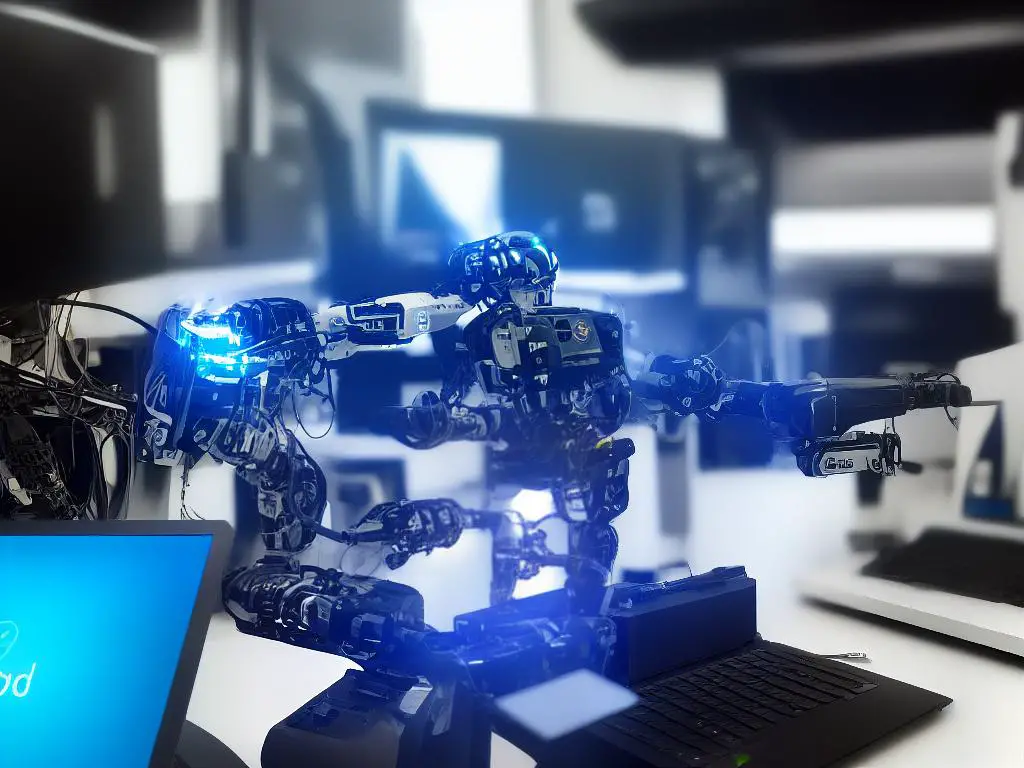The evolution of software development has brought about myriad complexities intertwined with immense opportunities. One such intricacy lies in dependency management, a fundamental aspect of modern-day programming that influences the effectiveness and efficiency of software projects significantly.
Balancing the increasing complexities and rapid pace of modern software is a difficult task, one that requires the adoption of advanced techniques and tools, notably those enabled by Artificial Intelligence. This transition is the heartbeat of the discourse on AI-powered dependency management on GitHub.
Thus, we embark on the exploration of the origin of dependency management, its relevance, and inherent challenges. Following these foundational aspects, we delve into the revolutionary world of GitHub Actions before aligning this with the transformative power of Artificial Intelligence in software development. With a fitting combination of these aspects, we can then hone in on the centerpiece of our discussion: AI-powered dependency management on GitHub.
Understanding Dependency Management
Table of Contents
- 1 Understanding Dependency Management
- 2 Exploring GitHub Actions
- 3 Introduction to AI in Software Development
- 4 AI-Powered Dependency Management on GitHub
- 4.0.1 Embracing The Future of Coding with AI-Powered Dependency Management on GitHub
- 4.0.2 Combining AI with GitHub’s Dependency Graph
- 4.0.3 Dependabot: GitHub’s AI-Powered Dependency Sleuth
- 4.0.4 The Advantages of AI-Powered Dependency Management
- 4.0.5 The Evolution of Dependency Management through AI: Looking into GitHub’s Approach
- 5 In-depth Case Studies and Evaluations
Understanding Dependency Management
In software development, dependency refers to a scenario where one part of a software application depends on or uses other components to function correctly. This can cover anything from virtual libraries to modules or unique software packages, all of which are necessary for building efficient software applications. Dependency management, then, is the act of handling these different components and ensuring they integrate seamlessly into the software development process.
Role of Dependencies in Software Development
Dependencies play an integral role in software development. They facilitate the reuse of code and the building of complex systems from simpler components. They also enable leaner coding by allowing developers to use pre-existing solutions instead of writing the same code repeatedly. However, the management of these dependencies can become challenging as an application grows more complex.
Challenges in Dependency Management
The main issues that arise with dependency management include compatibility, transitive dependencies, duplication, and outdated dependencies. Compatibility issues can occur when an update in one component affects the functionality of another dependent component. Transitive dependencies – the dependencies of your dependencies – can also undermine the predictability and consistency in a software development environment.
Duplicates are another problem, especially when two parts of a project depend on two different versions of the same software package. Outdated dependencies can expose the application to security vulnerabilities or lead to the loss of latest features.
The Need for Automated Dependency Management
The challenges posed by manual dependency management have led to the rise of automated dependency management solutions. With modern software applications often being composed of hundreds or even thousands of different dependencies, manual management is time-consuming and error-prone.
Automated dependency management tools like Dependabot by GitHub offer a solution to these problems. They automatically check for outdated or insecure dependencies, reducing the risk of application failures and security threats.
AI-Powered Dependency Management on GitHub
As the world of software development moves towards more intelligent solutions, the use of AI in dependency management has increased. Dependabot, GitHub’s dependency management tool, takes advantage of this trend.
The AI-powered bot scans your project for any dependencies and cross-references them against a vast database of known vulnerabilities and the latest version of the software. It then automatically opens pull requests to upgrade the software to a safe, updated version.
AI further enhances this process by identifying patterns and predicting future problems before they occur. The use of historical and real-time data, combined with machine learning algorithms, gives the tool the ability to ‘learn,’ enhancing the predictability and efficiency of the dependency management process.
Mastering AI-Powered Dependency Management on GitHub
The journey to becoming proficient in AI-powered dependency management on GitHub commands a comprehensive understanding of automated dependency management, alongside an appreciation of the extra value that AI imparts on Dependabot. Once mastered, this mix of information enables you to administer dependencies with higher proficiency, minimizing the chance of potential security risks and application shutdowns, leading to amplified overall productivity.

Exploring GitHub Actions
Delving into GitHub Actions: Streamlining Automation and Dependency Management
One key feature within the rich GitHub ecosystem is GitHub Actions. Introduced in 2018, this powerful automation tool drastically improves developers’ efficacy and code optimization by modernizing the software development workflows right within your GitHub repository. This dynamic tool can be harnessed for various jobs, including code pushing, test running, and software deploying to further simplify dependency management.
Basics of GitHub Actions
In essence, GitHub Actions are event-driven, meaning that specified workflows are triggered as soon as particular activity happens in the repository. These activities can range from creating a pull request, pushing code, raising an issue, to numerous others–offering a level of seamless adaptability and flex.
Setting up a GitHub Action involves creating a workflow file – in YAML format – in the ‘.github/workflows’ directory of your repository. This workflow file determines what happens when the designated event is triggered.
GitHub Actions comprehend three core components: ‘Triggers’ that set off the workflow, ‘Jobs’ that represent the execution sequence, and ‘Steps’ that are individual tasks within jobs. A single workflow can contain multiple jobs – each with numerous steps, offering countless workflow possibilities and automations.
GitHub Actions and Dependency Management
Often, software projects have multiple dependencies – libraries, frameworks, or other software that the project needs to run correctly. Developers must manage these dependencies and ensure that they’re using the right versions compatible with their project. That’s where GitHub Actions fits in, automating software dependencies updating and management.
GitHub Actions, with the power of AI, can help in managing and updating project dependencies. The tool, leveraging Dependabot – another GitHub feature, frequently checks your dependencies for any updates or security vulnerabilities. If it finds any, it can either automatically update it by creating a pull request, or generate a security alert, based on how you configure it.
Using GitHub Actions for Dependency Management: Real-Life Examples
Several software projects leverage GitHub Actions for dependency management. For instance, ‘Vue.js,’ a popular JavaScript framework, uses Dependabot integrated with GitHub Actions for their dependencies updates. They’ve set up Dependabot to scan their dependencies weekly and create a pull request if updates are available.
Another example is the ‘Microsoft Azure SDK’ repository. Here, the team uses a combinatorial matrix strategy. They’ve created a workflow that tests their code across multiple platforms and language versions whenever a new pull request is created or whenever someone pushes code. This ensure their code is always compatible with all dependencies.
Finally, the WordPress developer team recently revamped their outdated Travis CI system in favor of GitHub Actions. By utilizing several custom and community Actions, they’ve successfully automated their plugin deployment, coding standard checks, and, of course, their dependency management. This has improved their release cycle and general workflow efficiency.
Unleashing Automation in Repositories with GitHub Actions
GitHub Actions has brought a transformation in how we manage repositories, particularly in automating tasks and maintaining dependencies. This step presents a new approach to modern development strategies, providing an opportunity to simplify workflows, maximize productivity, and ensure consistency and compliance in code. Moreover, when GitHub Actions is employed in tandem with Dependabot, it provides a comprehensive resolution to the frequent challenge of dependency management.

Introduction to AI in Software Development
The Intersection of AI and Software Development
The current tech landscape is dominated by an intriguing intersection of Artificial Intelligence (AI) and software development. These overlapping spaces are instigating revolutionary changes, reshaping how we interpret and carry out software projects.
Within software development activities, AI emerges as a viable tool for automation, reviewing code, spotting bugs, and managing dependencies. It empowers developers to handle coding complexities while aiding in decision-making. A popular illustration of this power is the rising trend of AI-enhanced dependency management on GitHub that is transforming our perspective on the Software Development Life Cycle (SDLC).
The Impact of AI in Software Development
AI in software development is transforming the way developers code, debug, and manage software projects. Automated code review, powered by AI, is becoming a pivotal tool, enabling developers to locate and reduce coding errors, improve code quality, and ultimately save time and resources. As for bug detection, AI is a game-changer that can identify and propose solutions to fix bugs in the system, reducing debugging time successfully.
However, AI’s most overlooked and underappreciated role is arguably dependency management – a complex task that, until now, required painstaking manual oversight.
AI-Powered Dependency Management – A New Frontier
Dependency management in the software development world refers to the process of handling the interdependencies between different components within a software project. This typically includes managing libraries or modules the application needs to compile and execute effectively and efficiently. Thus, it’s a critical aspect of modern software development.
With AI, dependency management becomes a breeze. It empowers developers to effectively manage and track dependencies, automate updates, detect security vulnerabilities, and identify incompatible dependencies at the early stages of the development process.
And GitHub, one of the most popular and trusted platforms for software developers, offers an AI-powered tool that takes dependency management to the next level.
Diving into AI-Powered Dependency Management on GitHub
GitHub offers a tool known as GitHub Dependabot, an AI-powered system aimed at managing project dependencies efficiently.
Dependabot stands out as one of the top tools for handling the complexities of dependency issues. With its smart, automated system, this tool can tackle everything from security vulnerabilities to compatibility problems.
- Dependabot’s first major function is the automation of dependency updates by generating pull requests. Consistent updating of dependencies is a critical practice that enhances your codebase and maintains the security and reliability of your application. However, manually tracking and updating these dependencies can be tedious and time-consuming. Dependabot lightens this burden by automatically handling dependency tracking and updates.
- Next, Dependabot plays a crucial role in identifying security vulnerabilities. When using dependencies, security can’t be overlooked as outdated or malicious packages could pose potential threats to your application. Dependabot promptly alerts users of these vulnerabilities and generates pull requests to update the insecure dependencies.
- Furthermore, Dependabot can locate and rectify compatibility issues within your dependencies. By running your project’s test suite against newly updated dependencies, Dependabot ensures these updates don’t introduce breaking changes to your application.
All in all, the AI-powered dependency management provided by GitHub simplifies the software development process and promotes project health. By automating tedious tasks, it saves developers considerable time and effort, affording them more time to focus on the essentials of their application. The introduction of AI in coding represents a new era in which developers are empowered to produce more secure, efficient, and reliable software.

AI-Powered Dependency Management on GitHub
Embracing The Future of Coding with AI-Powered Dependency Management on GitHub
Dependency management forms a vital component of coding practices on GitHub. The process involves the organized handling of libraries, modules, and other software projects that your own project relies on. With the growing intricacy of the software ecosystem through the years, dependency management has become an increasingly complex task.
Recognizing the challenges presented by this complexity, the tech industry has turned to AI to simplify and enhance dependency management processes. In stride with this development, GitHub, one of the world’s leading software development platforms, has also begun incorporating AI-powered dependency management into its system.
Combining AI with GitHub’s Dependency Graph
GitHub’s Dependency Graph offers an overview of the packages and applications your project depends on. In other words, it allows you to understand how modifications to one component might affect others.
The introduction of dependabot, an AI-powered tool that offers automated dependency updates, has significantly enhanced Dependency Graph. It evaluates your project’s dependencies and generates pull requests to update them once new versions are released.
Dependabot: GitHub’s AI-Powered Dependency Sleuth
Dependabot plays an integral role in maintaining the health of your project. It continually checks your dependencies and when it locates a vulnerable one, it sends you a corresponding alert. It then creates a pull request with the details of the problem and an upgrade for the outdated dependency.
This AI-enabled bot also prioritizes security updates. If an exploitable vulnerability is detected in a dependency, Dependabot notifies you immediately regardless of your usual update schedule. Moreover, it provides critical compatibility data before you merge by running your test suite against any new update.
The Advantages of AI-Powered Dependency Management
Automating dependency management provides numerous advantages for developers. First, it saves a great deal of time by streamlining a process that would typically require intensive manual effort.
Second, it enhances a project’s security by promptly updating vulnerable dependencies. With AI at the helm, you’re less likely to miss important updates that can protect your project from potential security threats.
Third, AI-powered dependency management ensures that your project takes advantage of the latest updates, keeping your codebase up to date and potentially improving your software’s performance.
The Evolution of Dependency Management through AI: Looking into GitHub’s Approach
GitHub has taken a remarkable step towards enhanced software development practices by introducing AI-powered dependency management. The incorporation of AI in GitHub not only revolutionizes dependency management but also allows developers to concentrate more on software creation rather than maintenance tasks.
In this era of rapidly evolving tech, adopting Dependabot and other AI-powered tools can greatly enhance project productivity and security. It’s a smart investment to embrace AI in order to efficiently navigate the ever-complicated world of coding and software development.

In-depth Case Studies and Evaluations
Insights into AI-Driven Dependency Management on GitHub: Pioneering the Future of Software Development
Regarded as one of the indispensable platforms in the landscape of modern software development, GitHub offers developers the functionality to clone, build, pull, and push their projects. Its recent adoption of Artificial Intelligence (AI) for managing dependencies marks a significant transition in this space.
Understanding the term ‘dependency’ is pivotal for a comprehensive view of the topic. Essentially, a dependency is like a cog in a wheel – a software module or library indispensable for a project to work properly. They are usually generated by other developers and are shared across various package managers including npm, NuGet, and Maven.
Case Study One: Microsoft’s Use of AI in Dependency Management
One prominent organization that has successfully harnessed AI-powered dependency management on GitHub is Microsoft. As a tech giant champion in the software development world, Microsoft embarked on its journey of AI implementation in a project seeking to ramp up and automate the process of dependency updates on GitHub.
The project, known as “Dependabot,” leverages AI to handle tedious tasks of updating dependencies in a GitHub repository. Microsoft was keen on automating this process which often requires much human effort and potential risk of errors.
The result? Remarkable. Microsoft’s early adoption of AI-powered dependency management led to increased productivity, improved software security, and minimized development cycle times. Software projects that were once plagued by delays due to slow processing of dependency updates took a 180-degree turn.
Case Study Two: Uber’s Advanced Dependency Management
Another case worth examining is that of Uber. The ride-sharing mogul maintains numerous large-scale projects on GitHub, all of which are heavily dependent on third-party libraries and frameworks. Manual dependency management in such a setup could be not only challenging but also highly susceptible to errors and threats.
With the adoption of Dependabot, Uber managed to streamline dependency updates, thereby benefiting from enhanced security, minimized development cycle time, and improved productivity. The AI-powered bot identified outdated dependencies and opened pull requests automatically for necessary updates, reducing the workload on Uber’s engineers.
Best Practice and Lessons Learnt
The success stories of Microsoft and Uber using AI-powered dependency management on GitHub came with several best practices and lessons learned.
- Firstly, early adoption of AI in dependency management facilitates improved security as outdated dependencies are a common target for attackers.
- Secondly, automating dependency management allows developers to focus on mainline coding and other strategic tasks.
- Lastly, focusing on transparency and visibility proves critical in handling potential errors and threats.
Companies who are still on the fence should consider adopting AI-powered dependency management tools like Dependabot, as these can significantly reduce time, enhance security measures, and ultimately contribute to a more efficient development workflow. Particularly, organizations that maintain multiple large-scale projects would benefit greatly from such automated systems.
As AI continues to advance, dependency management on GitHub is merely one example of how this technology can revolutionize the way we approach software development. The potential benefits are significant, and the opportunities for further automation and integration are limitless. It’s an exciting time to be involved in this transformative field.

Immersing ourselves in the examination of AI-enabled dependency management on GitHub has provided deep insights into a vastly promising area that promises to redefine software development. The voyage started off by setting the context of dependency management and how it affects software development before branching out to understand GitHub Actions’ role and significance.
We gained an understanding of AI’s impact on software development and how that veers into dependency management. The crux of our exploration was undoubtedly the practical demonstrations of AI in dependency management on GitHub, a wholly rewarding yet complex system.
Diverse and comprehensive case studies helped us comprehend and evaluate real-world instances of this system in action. What emerges is a vivid picture of an intricate yet potent interplay of modern technologies that navigates dependencies, thereby enhancing project efficiency and accelerating progress. By extending the boundaries of possibility with AI, developers can exploit these tools and strategies, making dependency management a strength rather than a hindrance.

I’m Dave, a passionate advocate and follower of all things AI. I am captivated by the marvels of artificial intelligence and how it continues to revolutionize our world every single day.
My fascination extends across the entire AI spectrum, but I have a special place in my heart for AgentGPT and AutoGPT. I am consistently amazed by the power and versatility of these tools, and I believe they hold the key to transforming how we interact with information and each other.
As I continue my journey in the vast world of AI, I look forward to exploring the ever-evolving capabilities of these technologies and sharing my insights and learnings with all of you. So let’s dive deep into the realm of AI together, and discover the limitless possibilities it offers!
Interests: Artificial Intelligence, AgentGPT, AutoGPT, Machine Learning, Natural Language Processing, Deep Learning, Conversational AI.

